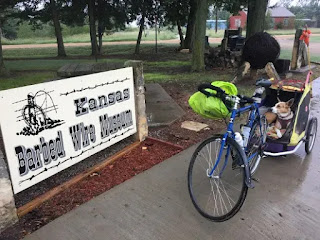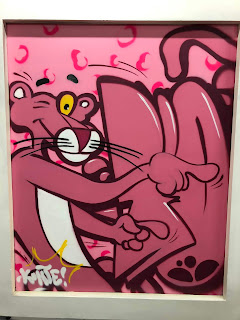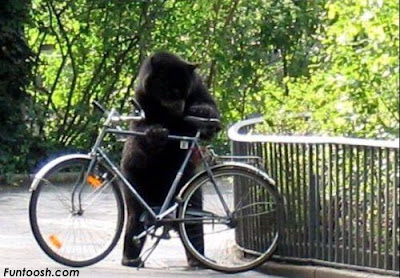How bad are the Middle Street bike lanes in Portsmouth, New Hampshire?
Not having ridden them, I don't really know. But I can tell you this: They've been panned by both motorists and cyclists. Oh, and school kids aren't crazy about them, either.
Drivers made at least one of the usual criticisms: They took away two of "their" lanes. Perhaps more to the point, though, the bike paths force them, as one driver pointed out, to cross the double yellow line dividing northbound from southbound traffic when passing. Also, the buses don't have a place to pull over when picking up or discharging passengers.
The pupils' dislike of the lanes was observed by attorney Charles Griffin. At a meeting of the city's Parking and Traffic Safety Committee, he recounted his own informal survey, taken from his car. He sat at one intersection between 7:50 and 8:20 am--the time during which most kids are going to school--on 15 mornings. "On two days, there were two students; on seven days there were (sic) one student; on six days, no students at all. Most kids who rode their bikes to school, he said, used the sidewalk instead of the bike lane. "I suspect they did because they didn't feel safe" using the lane "because it's too close to traffic," he speculated.
This was a poignant criticism, from the city's standpoint, because one of the arguments used to sway reluctant community members was that the lanes "would result in significant numbers" of kids riding to and from school, according to Griffin.
As an educator, I understand that young people often know more than we realize. That point was underscored by cyclist Roger Peterson who complained about debris, including wet leaves, in the lane. On his ride to the meeting at City Hall, he said, he also saw recycle bins scattered throughout the lane.
But if that were the only problem with the lanes, it could be fixed by maintenance. His and other cyclists' main issue, he said, is that the lanes are "very narrow and restrictive." Before the lanes were built, Peterson said, Middle Street "seemed to be one of the safest roads in the city." The street was "wide enough" for cyclists "to avoid traffic and for traffic to avoid the bicycles," he explained.
"It's puzzling as to why a bicycle lane was put in there," he addded.
I could make--and have made--the same criticisms, almost verbatim, about some of the bike lanes I've ridden here in New York and other American locales. Sometimes it is actually safer to have enough room on the street for cyclists and motorists to maneuver around each other than it is to have a lane that restricts both cyclists' and motorists' movements. Moreover, making turns--especially right turns--or going straight through an intersection when motor vehicles (especially trucks) are turning right is actually more dangerous when a cyclist has to leave a bike lane than it is if he or she is riding continuously along a street or road.
The worst part is that such lanes actually increase tensions between cyclists and motorists: The latter believe that lanes "take" "their" roadway away from them, while the former become frustrated with motorists' impatience. This could lead to city planners and administrators deciding that no bicycle infrastructure project is worthwhile and to removing whatever good infrastructure might have been created.
As I said previously, I've never ridden the Middle Street bike lanes. So, in all fairness, I don't want to suggest that they are worse than other lanes, including some I've ridden. But I can't recall hearing of another lane that received such resounding criticisms from both cyclists and motorists. And those criticisms are an accurate reflection of the misconceptions--and, sometimes, sheer folly--behind the planning and building of bike lanes.
Not having ridden them, I don't really know. But I can tell you this: They've been panned by both motorists and cyclists. Oh, and school kids aren't crazy about them, either.
Drivers made at least one of the usual criticisms: They took away two of "their" lanes. Perhaps more to the point, though, the bike paths force them, as one driver pointed out, to cross the double yellow line dividing northbound from southbound traffic when passing. Also, the buses don't have a place to pull over when picking up or discharging passengers.
The pupils' dislike of the lanes was observed by attorney Charles Griffin. At a meeting of the city's Parking and Traffic Safety Committee, he recounted his own informal survey, taken from his car. He sat at one intersection between 7:50 and 8:20 am--the time during which most kids are going to school--on 15 mornings. "On two days, there were two students; on seven days there were (sic) one student; on six days, no students at all. Most kids who rode their bikes to school, he said, used the sidewalk instead of the bike lane. "I suspect they did because they didn't feel safe" using the lane "because it's too close to traffic," he speculated.
This was a poignant criticism, from the city's standpoint, because one of the arguments used to sway reluctant community members was that the lanes "would result in significant numbers" of kids riding to and from school, according to Griffin.
As an educator, I understand that young people often know more than we realize. That point was underscored by cyclist Roger Peterson who complained about debris, including wet leaves, in the lane. On his ride to the meeting at City Hall, he said, he also saw recycle bins scattered throughout the lane.
But if that were the only problem with the lanes, it could be fixed by maintenance. His and other cyclists' main issue, he said, is that the lanes are "very narrow and restrictive." Before the lanes were built, Peterson said, Middle Street "seemed to be one of the safest roads in the city." The street was "wide enough" for cyclists "to avoid traffic and for traffic to avoid the bicycles," he explained.
"It's puzzling as to why a bicycle lane was put in there," he addded.
I could make--and have made--the same criticisms, almost verbatim, about some of the bike lanes I've ridden here in New York and other American locales. Sometimes it is actually safer to have enough room on the street for cyclists and motorists to maneuver around each other than it is to have a lane that restricts both cyclists' and motorists' movements. Moreover, making turns--especially right turns--or going straight through an intersection when motor vehicles (especially trucks) are turning right is actually more dangerous when a cyclist has to leave a bike lane than it is if he or she is riding continuously along a street or road.
The worst part is that such lanes actually increase tensions between cyclists and motorists: The latter believe that lanes "take" "their" roadway away from them, while the former become frustrated with motorists' impatience. This could lead to city planners and administrators deciding that no bicycle infrastructure project is worthwhile and to removing whatever good infrastructure might have been created.
As I said previously, I've never ridden the Middle Street bike lanes. So, in all fairness, I don't want to suggest that they are worse than other lanes, including some I've ridden. But I can't recall hearing of another lane that received such resounding criticisms from both cyclists and motorists. And those criticisms are an accurate reflection of the misconceptions--and, sometimes, sheer folly--behind the planning and building of bike lanes.






































